Tulip bulbs: planting and storage features

Growing tulips is a fun and very beautiful experience. Hundreds of varieties, thousands of shapes and colors of flowers attract more and more new owners. But in order to preserve the beauty of tulips from year to year, it is necessary to dig out their bulb annually, and then plant it back correctly at the right time. Only in this way can you be sure of getting a beautiful and abundant flowering.
What it is?
Tulip bulbs are an important plant organ, at the same time it is a root and a modified shoot. It is he who is considered and in fact is the most important part of the plant. It contains all the essential nutrients and minerals that are needed for the normal growth and development of the flower.
The roots of tulips are called tubers, and it is from their state of health, integrity and proper care of them that how, when and how much the plant will bloom.

Proper care of the bulbs, or rather, their timely digging, correct planting and disembarkation determine whether a particular variety of this flower will be modified. Without proper care, it can degenerate, and a few years after planting the bulbs, there will be no trace of the former tulip.
In addition, tulip bulbs have such a structure that after flowering, division occurs in them, that is, daughter tubers appear. Therefore, digging them out allows not only to quickly multiply the variety of flowers you like, but also to preserve their health and original appearance.
The tulip tuber is their most important organ, therefore, it requires a particularly attentive and careful attitude towards itself.
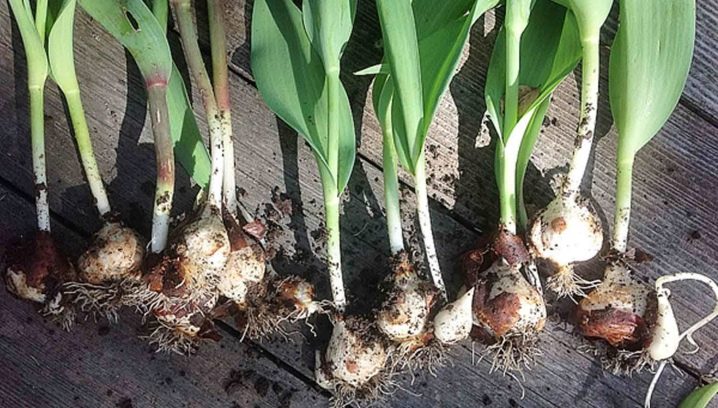
Landing dates
These beautiful, delicate, but at the same time bright flowers are considered one of the earliest. Indoors - greenhouses, the first flowers are already ready for cutting in early March. In the open field, some varieties bloom in early April.
The planting time of tulip tubers is significantly different from that generally accepted for all tuberous flowers.
Traditionally, it is believed that the planting of such plants should be carried out at the beginning of spring. So, here tulips are an exception to the rule. Planting their bulbs is carried out in the fall.
This is due to the fact that in winter the tubers undergo so-called natural stratification, that is, they are exposed to rather low temperatures. The result is the rapid emergence of the first shoots and early flowering of tulips.

The exact time of planting these bulbs depends on the climatic zone. In some regions, this may be the last days of October, and in some areas - early December. Therefore, experienced flower growers recommend choosing the time for planting tubers in such a way that after 3, maximum 4 weeks, winter frosts have already come.
In this case, the bulbs will not yet start to sprout, but with the onset of heat, on the contrary, they will begin to develop as intensively as possible.
In case of urgent need, you can plant tubers in the spring. Time - no later than mid-March, and preferably as soon as the snow melted.

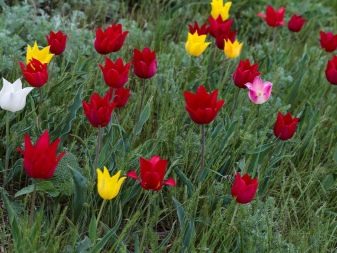
How to plant?
You can grow tulips not only in the open field, but also in a greenhouse, and, if necessary, in an ordinary apartment. The sequence of actions in each case will be slightly different.
In the apartment
Growing your own tulips by March 8 in a pot on your window can be quite simple. To do this, planting tubers is carried out in September or early October.
First of all, you need to prepare substrate for planting tubers. As a rule, peat is used in its pure form or diluted with river sand in a ratio of 3: 1. Compost is also an obligatory addition, it is the substances in its composition that will stimulate the correct and rapid growth and development of tulips. The compost adds 100 g of the mixture per 1 kg of peat. This also adds about 30-50 g of sawdust.


As a container, you can use a pot with a volume of up to 500 ml for planting one tulip each or wide containers with a pallet for planting several bulbs at once in one container.

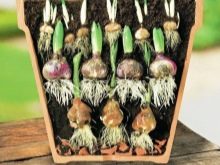

The further sequence of actions will be as follows:
- the prepared container is filled with soil, without adding 2-3 cm to its edges;
- the substrate is spilled with warm water, and the bulbs are placed in small holes in such a way that their upper third is open on the surface;
- the container is installed in rooms with a temperature of +8 to +10 degrees with normal daylight.
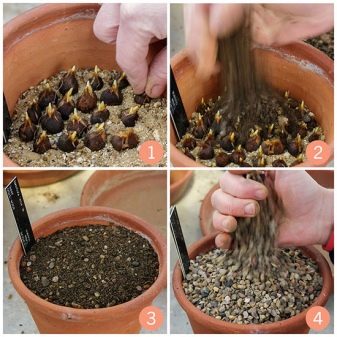
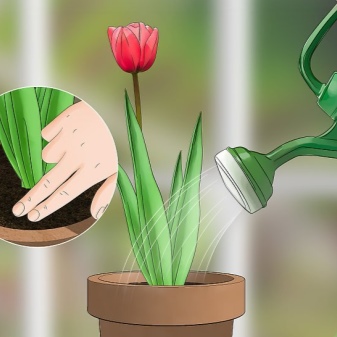
After the sprouts reach 5 cm in height, they are rearranged on ordinary window sills.
In order for the tulip tubers to take root, indeed, quickly and efficiently, after planting in the ground, they should be shed not just with water, but with a solution of calcium nitrate. For 5 liters of water, take 10 g of powder.
If, after such irrigation, the soil in the container shrinks strongly, it is necessary to fill in a new container in such a way that only the upper third of the plant remains on the surface again.

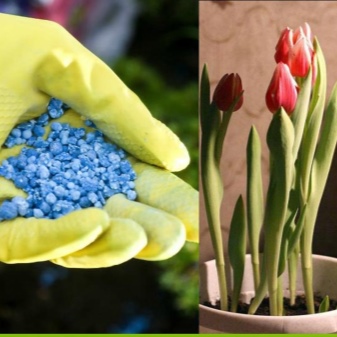
In the greenhouse
Before you start planting tulip bulbs in a greenhouse, the seed is kept in a room with a temperature of +9 degrees. On the day of planting, the tubers are cleaned of the upper scales - this way they take root faster.
Planting bulbs in a greenhouse is usually necessary for a holiday. To accurately determine the date of planting the bulbs, it is necessary to subtract 21 days from the expected date of cutting flowers - at this time, intensive growth of plants occurs and another 13 weeks, which are spent on cooling the tubers.
The containers and substrate are used the same as when planting flowers in an apartment:
- the container is filled with a substrate with a layer of about 12-16 cm and spilled with warm water;
- prepared bulbs are buried in the ground to a depth of 3 cm and sprinkled with soil on top, then spilled;
- then containers with seedlings are taken out into a room where the temperature does not exceed +9 degrees, and left for up to 13 weeks.
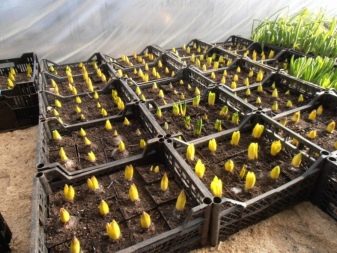
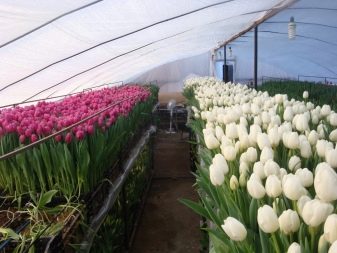
This preparatory stage is called refrigeration, and is necessary for the bulbs to accumulate nutrients and prepare them for rapid growth. At this time, the planted tubers are watered twice a week and make sure that they are not exposed to intense light. After the end of the stage, several consecutive actions are performed.
- The temperature in the greenhouse rises to +14 degrees, after a few more days it should be between +17 during the day and +13 at night. If it is necessary to accelerate the growth of flowers, the temperature is raised to +20 degrees Celsius.
- Illumination for the first time, until the height of the tulips reaches 7 cm, is kept at 900 lux. Then daylight hours are increased to 12 hours a day. The main advantage of tulips is that they do not need too intense light for normal growth and development.
- Water the flowers daily with cold water in small quantities.
- Twice during the entire period of distillation, if desired, you can feed the tulips with liquid fertilizer. But this is not necessary at all.
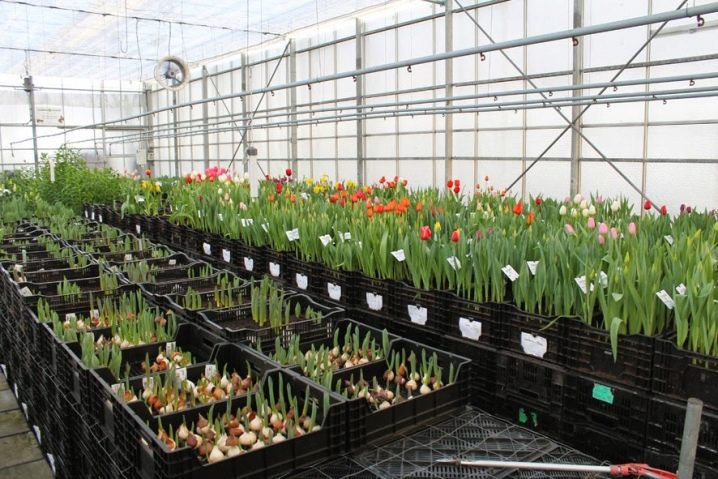
In the open field
On the street, the tubers are planted around mid-October. The place is chosen darkened, with light soil. In the ground, grooves are made with a depth of about 4 cm, it is important that their bottom is also loose.
Then at an equal distance from each other, about every 5 cm, the bulbs are planted. Top of the tubers are also sprinkled with earth and watered with cool water.
If frosts do not come, and there is drought on the street, then re-watering is carried out every 5-7 days. With the onset of the first frost, crops are mulched, and watering is stopped. After the snow has completely melted, the mulch is removed - otherwise it will close the tulip shoots.
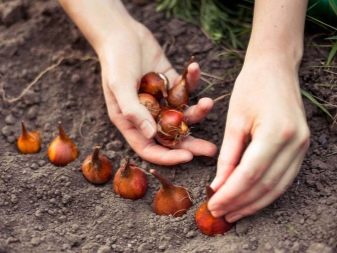

Further care
But regardless of whether the tulip bulbs were planted in an apartment, a greenhouse or even on the street, in order to obtain a lush and healthy flowering, the plant must be properly looked after.
In the greenhouse, the humidity must be maintained at 60%as well as water the seedlings regularly. Particular attention is paid to the intensity of illumination. It should not exceed the recommended level, otherwise tulips will begin to stretch, and their flowers will be faded and ugly.
From the video you will learn how to care for tulips in spring.
When growing flowers in an apartment, the basic conditions of care are the same as in a greenhouse, but here you should additionally carefully ensure that direct sunlight does not fall on the flower - they will burn the plant and spoil its appearance. When watering, it is better to use a watering can with a thin and long spout - so that the liquid does not get on the buds and leaves.
Regardless of where the tulip grows - at home or in a greenhouse, during the period of intensive growth, as well as at the moment when its buds are formed, experienced growers recommend using liquid dressings designed specifically for flowering or bulbous plants. They are used at intervals of 1-2 times within 2-3 weeks. Fertilizers are diluted according to the instructions.

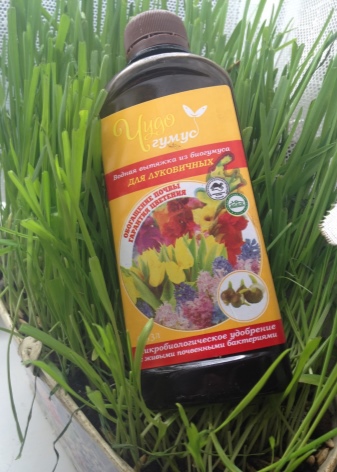
When growing flowers in the open field, carefully monitor their watering, as well as the degree of illumination. When a bud grows, you need to be careful not to be burnt by the sun's rays, which are especially insidious in the early spring months.
If tulips grow slowly in the open field, and their stem is too thin and elongated, then it is imperative to add additional dressing for bulbous flowers.

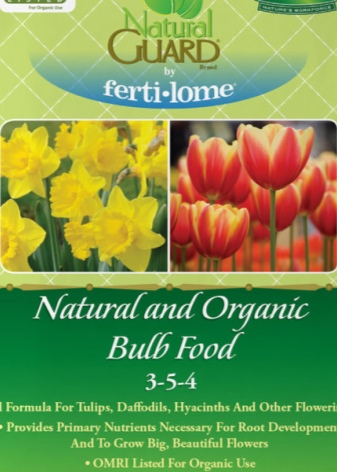
And no matter where the tulips are planted, it is very important to cut flowers on time - so the bulb retains the necessary nutrients not only for the cooling period, but also for further normal growth and development.
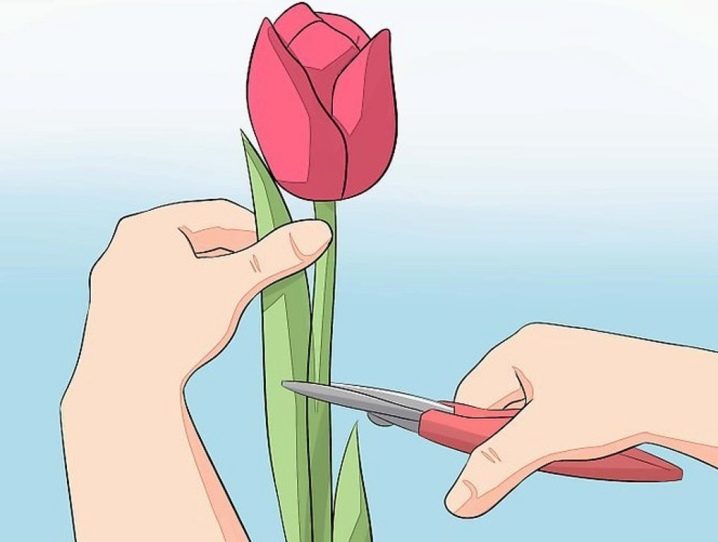
When and how to dig?
We have already talked about the need to dig up tulip bulbs and their subsequent correct planting. Now it's time to talk about when and how exactly this procedure should be performed.
- Tulip tubers are removed from the ground only after the flowering period is over.
- After the end of flowering, you need to wait about 2-3 weeks. It is best to wait until the lowest tulip leaves begin to dry out and turn yellow.
- The exact time of extraction of flower tubers from the ground depends on their variety. As a rule, in our country this period lasts from June to July.
- The excavation time must be chosen so that there is no rain, but also that the soil is not too dry. In the first case, it will be quite difficult to properly dry the bulbs and save them in the future. And in the second case, during their removal from the ground, they will crumble, and daughter bulbs may remain in it.

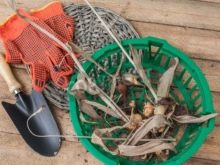

Dig up the bulbs very carefully using a small metal garden trowel. It is installed directly next to the stem in such a way that its lower part will go under the tuber and raise it to the surface.
When the bulbs appear on the surface, they are lifted by gently pulling them by the stems. Dig up tulip tubers carefully and slowly so as not to damage them.
How to prepare tulips for transplanting and storage, see below.
How to store?
The main task of the grower after digging out the tubers is to preserve them correctly in autumn and winter. Often, especially novice growers are faced with the fact that the bulbs are moldy or prematurely germinated.Therefore, it is necessary to clearly and consistently follow all the rules at each stage.
Preparing for storage
It is precisely the strict implementation of all the recommendations described below that will make sure that mold or mildew will not appear on the flower bulbs.
Immediately after removing the tubers from the ground, they must be sorted. Cut, damaged and too small bulbs are removed - they are not used as seed in the future.
It will be simply impossible to get beautiful, healthy and blooming tulips from such tubers.
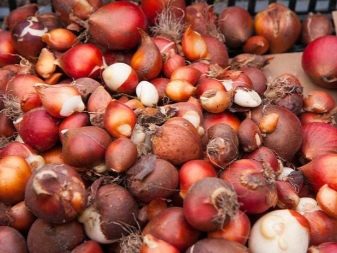
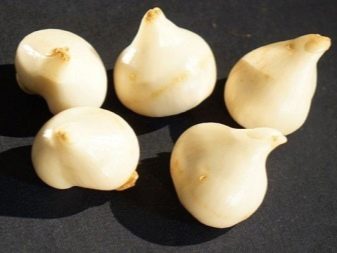
In addition, there are a number of steps to be taken.
- Remove dirt from the surface of the bulbs. If the earth has dried up, then it is carefully separated in pieces, but if it is wet and adhered in a thick layer, then the bulbs are washed. It is best to do this first in hot water, the temperature of which is about +40 degrees, and at the very end, rinse the tubers with a pale pink solution of manganese.
- The outer brown husk is removed from the daughter bulbs and separated from the mother tuber.
- If large bulbs are found to be damaged by fungus, you can try to rescue them. To do this, they are treated with a fungicidal solution, and then dried thoroughly.
If there are doubts about the quality of the seed, then even if the tubers were not washed, they are soaked in a manganese solution for 25 minutes.
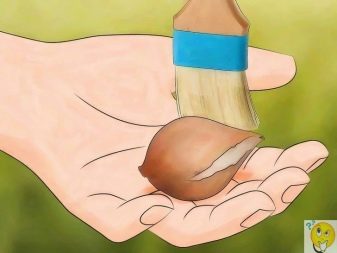

Drying
Even if the bulbs have not been previously exposed to moisture, they should be thoroughly dried before storing them.
To do this, the tubers are laid out on a flat surface so that they do not come into contact with each other. Place the onion tray in a dark, cool place with natural ventilation.
It is highly not recommended to dry them near heating devices or directly in the sun. The average drying time is 10 days.
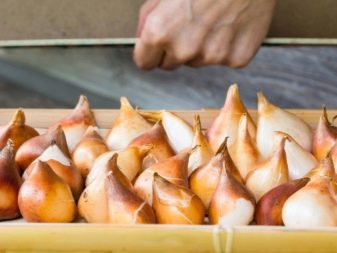
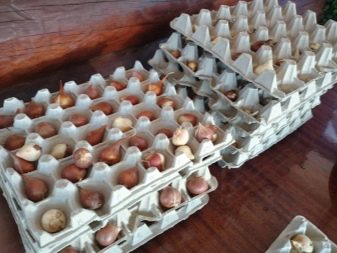
Where and what to store?
Tubers are laid out in a storage container depending on their size - you cannot store bulbs of different sizes together. Here it is worth remembering that the largest tubers survive storage best, but small ones often begin to disappear during storage, even if the storage conditions are met.
The best containers are wooden or cardboard boxes. Tulip bulbs need natural ventilation. Therefore, small holes are made in the cardboard.
Planting material of tulips is placed in containers in one layer, and on top is covered with a thin layer of sawdust or special moisture-resistant paper.
The optimal storage conditions for bulbs are:
- temperature from +3 to +28 degrees;
- complete lack of light;
- the optimum humidity level is from 55 to 70%.
In an apartment, the best place to store them will be a balcony or a glazed loggia. If we talk about storing bulbs in a private house, then here you can use a basement, pantry or underground. Particular attention should be paid to the absence of freezing temperatures, because frozen tubers are not subject to further planting.
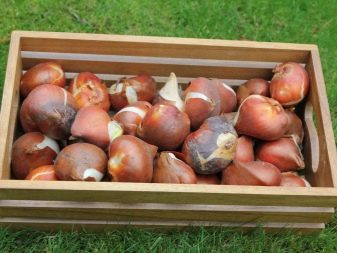
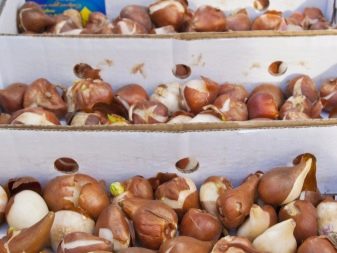
Now that you know all the information about the storage, digging and further planting of tulip bulbs, you can easily grow them at home and keep the seed in excellent condition.
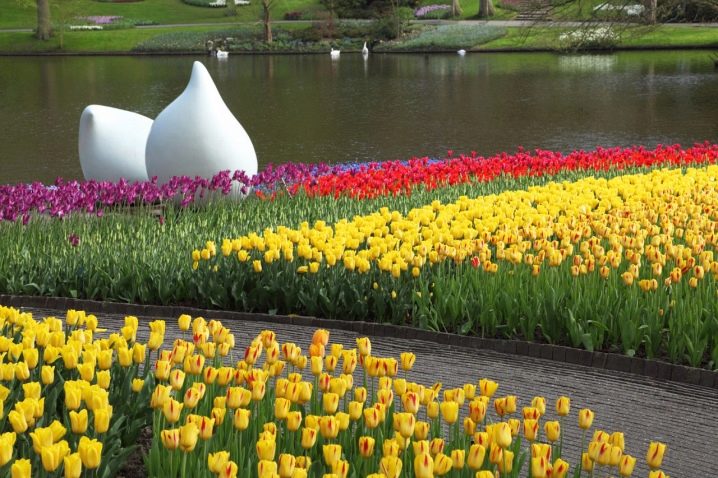







































































































The comment was sent successfully.